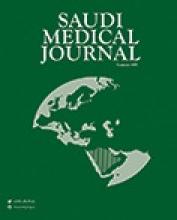Abstract
OBJECTIVE: To explore the diagnostic yield of transthoracic echocardiography (TTE), and assess the effect of echocardiographic findings on subsequent therapy.
METHODS: In this retrospective study, we reviewed TTE reports and hospital records of patients diagnosed with a stroke or transient ischemic attack (TIA), screening for potential cardiac sources of embolism (CSE) from January 2006 to December 2008 at King Khalid University Hospital, Riyadh, Kingdom of Saudi Arabia by considering at least 15 predefined TTE criteria. The therapeutic interventions employed as a consequence of the TTE findings were sought.
RESULTS: We analyzed 240 patients (mean patient age 58.5–14) out of 10563 TTEs. While only one patient exhibited a definite CSE on TTE, potential CSEs were found in 35 patients (14.6%), most commonly caused by left ventricular (LV) systolic dysfunction (31.4%), followed by LV regional wall motion abnormalities (25.7%). Multivariate analysis revealed 2 independent predictors for identifying a CSE on TTE: history of coronary artery disease (odds ratio [OR] 6.2, 95% confidence interval [CI]:2.6-14.8, p=0.0001), and nationality (OR 0.16, 95% CI: 0.3-0.7, p=0.019). The TTE findings affected therapy in only 3 patients (1.2%).
CONCLUSION: The TTE performed to exclude a CSE in patients with stroke or TIA resulted in low diagnostic yield, and had little impact on therapeutic decisions. Future refinement of clinical strategies to predict a CSE is needed to improve diagnosis, and possibly cost-effectiveness, of TTE.
- Copyright: © Saudi Medical Journal
This is an open-access article distributed under the terms of the Creative Commons Attribution-Noncommercial-Share Alike 3.0 Unported, which permits unrestricted use, distribution, and reproduction in any medium, provided the original work is properly cited.






